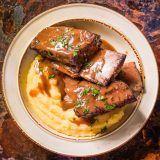Across Italy, there are countless variations of meat braised in a blend of wine, vegetables and herbs. But by far one of the most uniquely delicious—practically an icon of comfort food—is found in northern Italy’s Piedmont region: brasato al Barolo.
As the name implies, beef is slow-simmered in Barolo—a peppery, full-bodied and subtly floral red wine, often referred to as “il re dei vini, e il vino dei re.” That is, “the king of wines, and the wine of kings.”
Produced in Italy’s lush northwest, Barolo is made from thin-skinned Nebbiolo grapes. The variety is renowned for its high tannin and acid contents—qualities that, when harnessed properly, provide a perfect foil for fatty, beefy red meat.
“It’s just such a deeply satisfying braise,” says Scott Conant, James Beard Award-winning chef, restaurateur and author. “As you cook the meat, its fat melts into the reduction of vegetables and wine, creating a really well-rounded sauce.”
Enticed by the dish’s bold, comforting flavors, we set out to develop a similar special-occasion recipe. We began by turning to some of our favorite tricks for better, brighter braises.
The first order of business? Rethinking the wine. Red meat and wine indeed are a natural pair, but cooking them together can produce unpalatable results. Acid-forward alcohol often turns meat sour and, in the case of wine, bitter thanks to all the tannins it contains.
This is especially true of Barolo, which has a pronounced tartness and astringency that can make the dish delightfully well balanced, but only if incorporated with care.
To that end, we begin by gently simmering the wine, as is traditional, but take the technique a step further and reduce the Barolo’s volume by half, a process that eliminates any undesirable flavors while also coaxing out sweeter, fruitier notes.
From there, to continue building a base filled with concentrated flavor, we combine mushrooms, onions, carrots, celery and garlic with tomato paste and pancetta—two robust, umami-rich ingredients. Roasted at high heat until well caramelized, the mixture takes on a complex, savory flavor.
Additional depth comes in the form of dried porcini mushrooms, a frequent flavor enhancer in Italian cuisine. The earthy mushrooms and their soaking liquid are added directly to the braise, then slowly simmered alongside the meat.
For a more festive appearance, we swap the typically used lean roast for bone-in short ribs. The succulent, centerpiece-worthy cut is dependably well marbled and becomes increasingly tender when cooked for lengthy periods at low temperatures. Ribs also augment the sauce with a more gelatinous quality—an attribute Conant agrees greatly improves its texture.
Starting the ribs meat side down in the braising liquid promotes fall-off-the-bone tenderness. And after many rounds of testing, we found that flipping the ribs and roasting them uncovered for the last hour of cooking yields beautiful browning and caramelization.
The last touch is reducing the braising liquid, which takes on a bevy of earthy, vegetal, meaty and umami-packed flavors after hours in the oven, and incorporating a simple roux to produce a silky sauce, ideal for pouring over the ribs and any accompanying vegetables or starches.
“There’s just something incredibly warm and comforting about foods like this,” Conant says. We couldn’t agree more.
The combination of red wine and beef is such a classic it surprises many to learn that cooking the latter in the former actually can be a bad idea. That’s because cooking beef in wine that is poured directly from the bottle tends to leave it tasting bitter and a little sour.
This sourness is a result of wine’s acidity, which typically ranges from a pH of 3.0 to 3.6. This modestly strong acid is dominant enough to impart an unpleasantly tart taste to meat, especially when simmered in wine for long periods of time.
The other undesirable outcome—the bitterness—is a byproduct of tannins, a naturally occurring compound found in plants. They bind tightly with proteins, including those in human saliva, to create the dry, mouth-coating sensation associated with tea, coffee and, of course, wine. The same effect occurs when wine is combined with beef. The tannins bind to the abundant protein molecules in the meat, permeating it with an unpleasantly astringent taste.
Fortunately, there’s an easy solution: Simply reduce the wine before adding it to the meat. As the alcohol cooks off, the tannins bond with each other, lessening their astringency. Simultaneously, the sugars are concentrated, increasing the wine’s sweetness and offsetting the acid.







